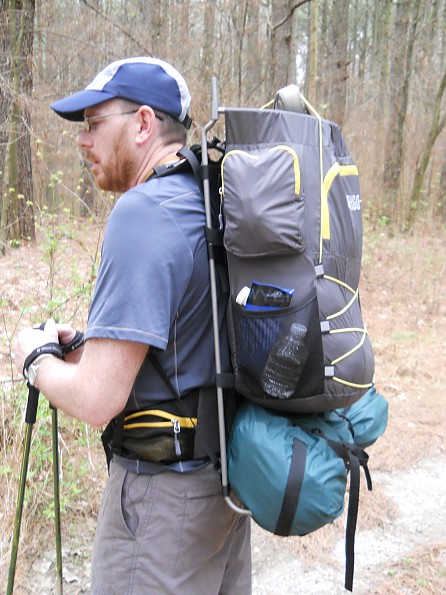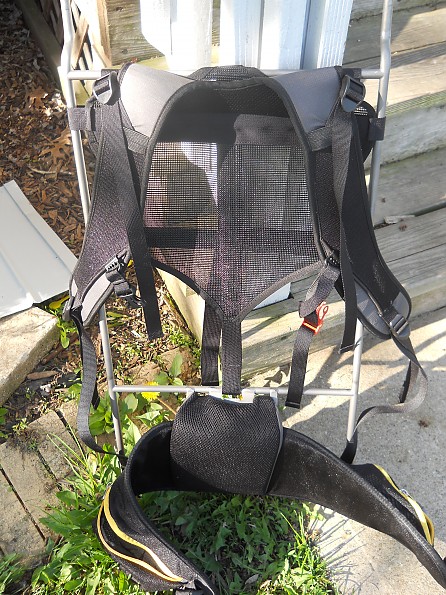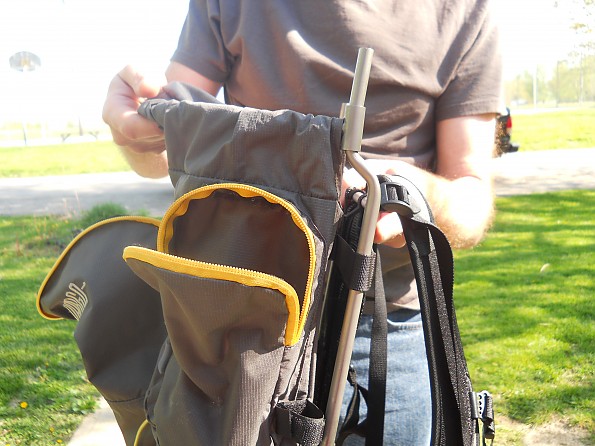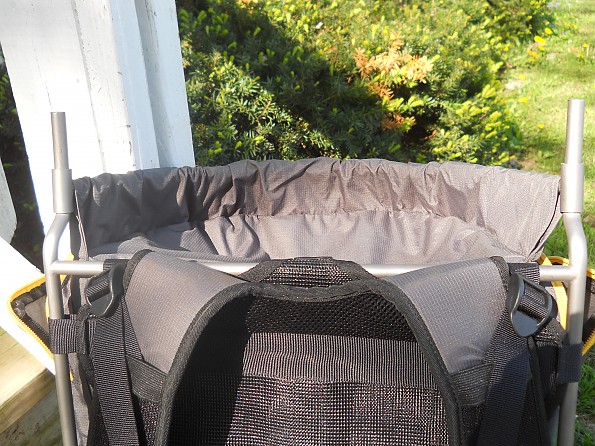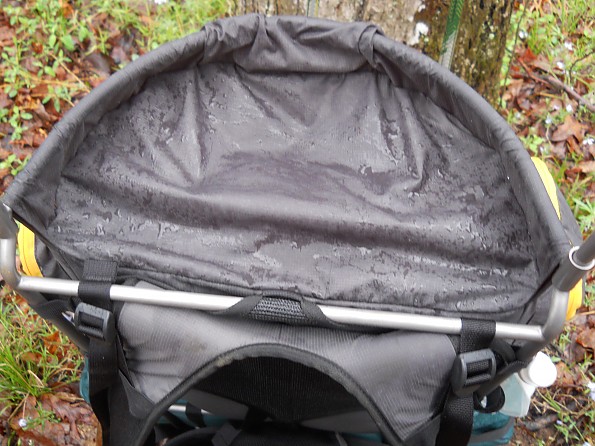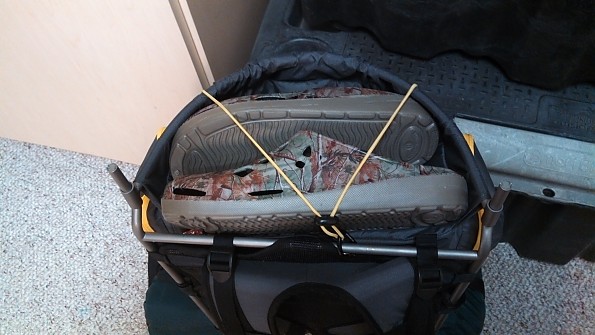Vargo Ti-Arc Pack

The external frame pack is back! The Ti-Arc is a first generation backpack from the company that brings us all things titanium. As an initial foray into pack design, the Ti-Arc is a solid first step, merging the best aspects of external and internal frames.
The design is innovative. The comfort is phenomenal. Vargo still has a few kinks to straighten out in the design. However, the Ti-Arc has decisively brought the external frame pack back out of obscurity. This is the pack I want with me on the trail!
Pros
- One of the lightest external frame Ppacks on the market
- Quality construction, durable materials
- Extremely comfortable
- Fits well
- Pack rides where it is suppose to
- Airflow keeps your back cool
- Clever design negates the top-heavy nature of External Frame Packs
Cons
- Only 36 liters of internal storage
- Odd, inefficient top
- Design prevents use of rain cover
- Can snag on low hanging vines
- Needs more straps or more loops to add straps
- Belt designed for wider-girthed hikers
- Small front-loading opening
- Price
Preface: I spend a good portion of this review suggesting areas of improvement. But if I were setting out on the Appalachian Trail today, this is the pack I would be carrying. Yes, it weighs a pound more than my UL internal frame pack, but that is a reasonable tradeoff for the comfort and stability it provides.
The greatest “con” to this pack is I'm not sure I can go back to using another one, knowing how good this one feels.
Testing Conditions
I spent six days hiking 85 miles of the River-to-River Trail in Shawnee National Forest. The Shawnee hills provide continuous elevation change similar to hikes in the Appalachian Mountains (although elevation is, overall, lower). I hiked roughly15-17 miles, most days.
The trail presented scores of stream crossings and climbs over fallen trees. Often times a good “jump” was needed to get across obstacles. Footing ranged from gravel roads to rocky ascents to muddy horse tracks. I set out with a pack weight of 25lbs 3oz, including all consumables.
The Reviewer
I am a 46yo male, standing 6'2” with a 34” waist. Arthritis in both my knees has forced me towards a “Light” (but not a true “Ultra Light”) approach. I have found a baseweight of 13-15lbs keeps me comfortable both on the trail and in the campsite.
An UltraLight Pack?
The first argument any ultralightest is going to make is that 2lbs 13oz is on the heavy side for a pack claiming to be “ultralight.” Add to this the fact that Vargo gets to that weight by reducing overall capacity to 36 liters. The Ti-Arc holds to the “old school” mindset that people still want to strap their rolled up sleeping bag to the bottom of the pack.
For my own usage, I had to grab a large compression sack, thread the straps through the frame, and carry my tarp and hammock here. The compression sack weighs in at 6.2oz. So in actuality, my pack weighed 3lbs 3.2oz (versus my 60 liter internal frame pack at 1lb 13oz.)
- Suggestion #1: Forget about marketing this as UL. Increase the body of the pack to the full length of the frame to increase volume (also makes side pockets deeper). If that is too much of a design change, at least add integrated compression straps to the bottom of the pack so that any stuff sack can be strapped here.
Construction & Durability
A second, positive reason this isn't an UL pack is that the materials are too durable. Ultralightests know they sacrifice longevity in the name of saving weight. The Ti-Arc relies on 70 denier ripstop nylon for the bag. This is both light and durable. I never worried about the need to baby this pack to keep from damaging it.
Comfort, Fit & Ride
This is where the Ti-Arc blows away anything else I have ever used. I will gladly sacrifice a full pound from my internal frame pack for the comfort of the Ti-Arc. UL hiking is about feeling comfortable and fresh at the end of the day. The Ti-Arc provided this. There was never a time when I groaned as I put it on. My shoulders and back were never stiff or sore during my six days on the trail.
-
The mesh backing on the frame allowed air to circulate across my back, keeping me from becoming hot and sweaty.
-
The adjustable lumbar support was worth every ounce of weight it adds to the pack. This feature alone was the best selling point of the Ti-Arc!
- The titanium frame supported the entire pack to keep it from sagging on my shoulders. This allowed the pack to move with me, rather than push or pull me on hills.
-
External frame packs are known for being top heavy. However, the Ti-Arc was simply perfect. I did not need to lean back on descents or lean forward on ascents in order to maintain my center of gravity. Vargo accomplishes this with a unique approach to attaching the bag to the frame.
-
One “con” on fit is that I nearly bottomed-out the belt with my 34” waist. Vargo's website says this will fit someone down to a 30” waist, but I am a bit skeptical of that claim. Were I to be dropping pounds on the AT, I would be concerned about becoming too skinny for this belt.
- Suggestion 2: Since the belt is easily removable, offer an optional, smaller belt.
Capacity
I've already mention that 36 liters is a bit sparse for the long trail. My first concern was could I really pack a week's worth of gear into this unit? I decided to over-test it, by not only packing what I planned to carry during my 6-day trip, but by adding everything I would take on a six-month trek on the Appalachian Trail.
Here is everything, I would intend to take with me, including a 10-day supply of food for the One Hundred Mile Wilderness in Maine.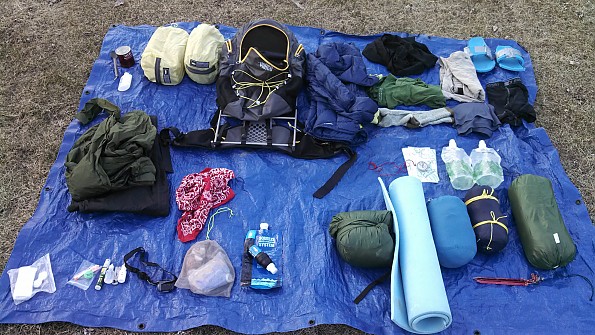
And here is what it looks like packed into the Ti-Arc: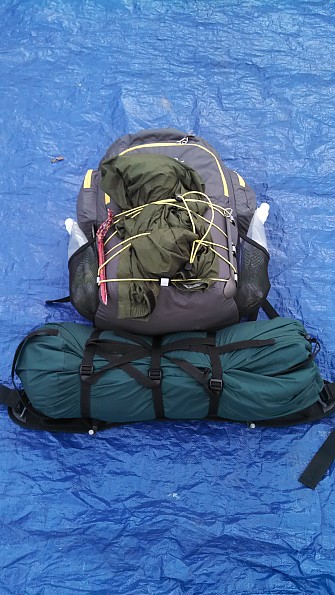
Success! Additionally, I discovered that during my 6-day trek I became more efficient at packing and repacking this unit. By the third day of the trip, I was questioning if I even need the compression sack attached to the bottom—but that was with my food bag half empty.
I listed as a “con” that the front-loading, zippered opening is a bit small. After a couple of days I was no longer noticing this. It may be that I just prefer a top loading pack, where it is easier to stuff things in.
- Suggestion 3: Make the pack top loading, with a roll top and drawn string (Maybe that's an entirely different model in the Vargo line of packs!).
Quirks in the Top Design
The entire top of the pack strikes me as inefficient. As shown previously, the bag slides onto the frame, which is quite clever. But the prongs extend so far above the bag they create two problems.
-
At one point I snagged on a low hanging vine. This jerked me to an abrupt halt and required a bit of gymnastics to get myself free.
-
I was unwilling to carry a rain cover, as I believe the prongs would tear a hole in it.
Instead of carrying a rain cover, I simply used a trash compactor bag inside the pack to keep gear dry, but that highlights more of the problems with the top...
Notice the recessed top of the bag. This frustrated me as wasted potential storage space.
But in rain, this recessed area simply became a water catch. This insured water would slowly seep into the pack instead of shedding it. A hiking partner sarcastically told me to put a pan inside the top of the pack, and I would have a new style of water filter.
I tried to find some use for this top area. However, tie-off points are lacking. One attempt was to place my camp shoes on top and stretch the bungee net over them. However, I found that I maxed out the cord in this attempt. So much so, I was unwilling to put my rain coat under it for fear of snapping it.
- Suggestion 4: Shorten the prongs as much as functionally possible to reduce snagging.
- Suggestion 5: Include a grommetted rain cover that will slide over the prongs
- Suggestion 6: Either get rid of the recessed area and add volume to internal storage, OR...
- Suggestion 7: Add a second bungee net to the top of the pack to shove in rain gear, and etc, OR...
- Suggestion 8: Add a few grosgrain loops to the top of the pack, along the “arc” suspension bar to tie items down
Price
Titanium is not cheap. At $300, the Ti-Arc is not the most expensive pack on the market, but it is the most expensive external frame pack I know of, with half the carrying capacity of many packs. My thought is many shoppers will compare a ratio of “cost of pack TO weight saved TO carrying capacity” and look past this pack. I feel that's a shame! Vargo is going to have to aggressively market this pack to overcome that ratio, and that marketing needs to focus on the comfort of the Ti-Arc.
- Suggestion 9: Sponsor a 46yo, fairly handsome guy with arthritis in his knees to hike long trails and be the spokesman for the comfort of the Ti-Arc. He will gladly quit his day job to do this.
Bottom Line
While not a true ultralight pack, the Ti-Arc definitely falls into the category of “light.” It is also the most comfortable pack I have ever used. I expect future versions of the Ti-Arc to continue to improve on the initial design. In its current version, the Ti-Arc is well worth taking on the trail.
It is simply the best pack I have ever used!
Source: received for testing via the Trailspace Review Corps
(Sample provided by Vargo for testing and review)
Bling backpack, in beta.
Pros
- Superbly designed lumbar pad and belt
- Rather light for its size
- Fine quality titanium parts
Cons
- Fits waists between 32"-50"
- Rather small for its weight
- Needs liner and external bag(s) to be more than a daypack
- Poor quality fabric to pack
- In use, feels half-tested and half-developed
The market Vargo is aiming for with the ti-Arc can be worked out by three statistics: the median fit for its waistbelt is over 40", the base model costs three hundred dollars, and its capacity is that of a generous daypack.
Rich weight-weenies out for a stroll & a picnic? Right...
...well, not far off as a judgement, if a bit unkind.
The basics are good—arguably very good: the (vented titanium) lumbar pad, its padding, and the associated waistbelt assembly are absolutely first rate—the perfect foundation for a good pack. The ti-Arc takes load straight to the hips, balances nicely, and is very comfortable.
The welding on the scarily thin-walled titanium tube frame looks beautifully done; and (unusually, in my experience) the load-lifters have just about enough angulation to work for a user at the 'tall' end of the ti-Arc's adjustment range, which adjustments are straightforward and solid.
At 36l, it's a bit small; but you can strap stuff onto that lovely frame, right?
Well, no: the ends of the frame-tubes are capped off square and sharp; *anything* strapped on that contacts these sharp ends will abrade through in short order. The target market—rich weight-weenies, remember—will be toting all sorts of exotic uberlight, fragile, branded goodies, strapped on all casual-like; the desired Look being Millionaire Tramp.
I feel that Vargo, if they had tested the ti-Arc in the real world, would provide the buyer with a more permanent and more graceful solution to the above issue than mine: *User tip* bore (9.5mm) and glue (with expanding polyurethane; Gorilla Glue or similar) corks to the tube-ends—works fine and, if I could afford champagne, could even look Millionaire Tramp.
There are far too many basic Design and Quality Control issues with the ti-Arc: the fabric of the pack is absolute rubbish stuff, not functionally rip-stop, and not seam sealed. Why O why haven't Vargo specified a genuinely durable lightweight ripstop, like Dyneema X? A trailing bramble tore the ti-Arc pack the second time I used it. *User tip* it required patching: a flexible urethane adhesive (Seam-Nett or similar) worked OK.
As it is not seam-sealed, and because the issue is exaggerated by the ti-Arc design having a birdbath at the top of the pack, a real-world user *must* use a pack liner. The ungenerous 'shark's mouth' entrance to the pack makes using a liner more difficult than it should be. *User tip* the Exped medium (50l) pack liner has a rectangular base; its size and shape matches the ti-Arc well.
Other infuriations are: the rubbery end to a zip's pull-cord pulled off at around its twentieth use, and the sternum-strap simply pops off its sliding attachments to the shoulder straps under load. The strange birdbath at the top of the pack *might* be usable for storage if it had some means to make securing items there possible—loops and an elasticated net would be great.
One last *User tip*—the ideal pack to go across the underside of the ti-Arc (once you've protected the tube-ends) is the Exped "Waterproof Compression Bag" - the 19l 'large' size fits just right and pulls the capacity up to a more practical 55l. Its compression straps—having unpicked the stitching to their folded-over ends—fit neatly between the uprights NS round both lower transverse bars of ti-Arc's frame to provide a very secure fastening, while compressing the bag.
Last words: I half-wish I'd bought the cuben version, at least it would be in principle waterproof (but is the zip waterproof?), and presumably more durable; however, this does without the genuinely useful pockets, and is an ambitious hundred dollars more. Even blingier, for those that see that as a positive...
Source: bought it new
Price Paid: £200
Your Review
Where to Buy
You May Like
Specs
| Price |
MSRP: $299.95 Historic Range: $299.49-$299.95 |
| Weight |
2 lb 13 oz / 1.28 kg |
| Volume |
36 L / 2,196 cu in |
| Maximum load capacity |
30 lb |
| Fits torso lengths |
20-24 in |
| Minimum waist size |
30 in |


